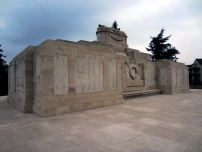| First Name: | David William | Last Name: | SWEENEY | |
|---|---|---|---|---|
| Date of Death: | 26/08/1914 | Lived/Born In: | Whitechapel | |
| Rank: | Private | Unit: | Warwickshire1 | |
| Memorial Site: | La Ferte-sous-Jouarre Memorial, France | |||
Current Information:Born-Whitechapel
Le Cateau 26th August 1914 By the evening of the 25th August, after their withdrawal south following the Battle of Mons on 23rd August, II Corps of the BEF, commanded by General Smith-Dorrien, had reached Le Cateau, in France. They had been retreating, but still fighting rearguard actions for two long days and they were done in. The Commander-in-Chief, Sir John French ordered them to continue the next day but Smith-Dorrien chose instead to stand and fight. He reasoned that with the Germans on their heels a retreat would be disastrous without first halting the enemy advance. So, on the next day II Corps turned and faced the enemy. The town of Le Cateau saw little of the actual fighting on 26th August, the main actions taking place along the line of the road running between Le Cateau and Cambrai. A fierce battle ensued when the Germans began an artillery bombardment at dawn. Their infantry followed up in the wake of this barrage and became the targets of both the British artillery and infantry. The Germans were held at bay until the afternoon but by then they were threatening the flanks of II Corps which withdrew, whilst the enemy reorganised. British casualties for the day, killed, wounded or taken prisoner, were nearly 8,000. As the main body of the British Expeditionary Force retreated from Mons, 4th Division hurried east across France to join up with them. By the 25th August they had reached Solesmes, an important town because roads from the north, north-west and north-east converged on it, roads down which the retreating army would travel and which the pursuing Germans would also use. Overnight they moved further south. By the following morning 4th Division were in a position around the village of Haucourt where they could cover the left flank of II Corps. Le Cateau was five miles to the east. Just to the north of Haucourt, running along a valley, is a small stream, the Warnelle Brook. Early on the morning of the 26th August, the 1st Royal Lancaster battalion crossed this stream to the high ground north of it where they came under a fierce attack that practically destroyed the battalion. Two companies of the 1st Royal Warwickshire battalion of 10 Brigade swarmed up the hill to help but they were swept away by machine-gun fire and shrapnel as they reached the crest. By 8.45am the enemy advance towards Wambaix around the left of the British line was well advanced and retirement was imperative. What was left of 1st Royal Lancaster were sent o the south side of Warnelle ravine and to cover them two companies of 1st Warwickshire counter-attacked from Haucourt against the ridge north of Longsart. They reached the crest but once again enemy fire forced them back after inflicting heavy casualties on the battalion. At 5pm 4th Division were ordered to retreat with 10 Brigade acting as rearguard. Unfortunately the briade were scattered with half of 1st Warwickshire and many of 2nd Royal Dublin Fusiliers still in Haucourt . That night, after beating off a German counter-attack this mixed party which included 300-400 of 1st Warwickshire made their way across country to Selvigny from where they continued the retreat. One of the battalion’s casualties during this day of heavy fighting was David Sweeney. |
||||
| « Back to Search Results | ||||
| If you think any of the information shown here is incorrect, Click Here to submit your amends and comments | ||||




